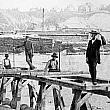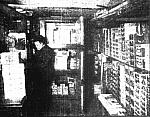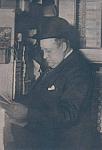
Steam Pipelines
by David Macaulay
Besides providing electricity, it is not unusual for an electric company to also provide steam. The first steam piped into a city was merely a by-product of the electrical generators and came therefore from the main power plants. Now, however, power plants exist in many cities for the sole purpose of producing steam. Steam is fed under pressure into a system of mains, submains, and service pipes. The mains and submains are two-inch-thick welded steel pipes, the largest of which are twenty-four inches in diameter.
Because of possible damage to other utilities from the heat, steam pipes are usually buried at least six feet below the surface and encased in concrete. The trench, which will act as a form for the concrete, is dug only a few inches wider and deeper than the pipe itself and the floor is carefully graded for drainage purposes. The sections of pipe are set on supports about six inches off the ground and welded together. Each connection must be absolutely airtight and is therefore x-rayed. Not until the x-rays are checked is the pipeline approved. At specific locations, steel straps called anchors are welded around the pipe. These will be permanently embedded into the concrete. Approximately every hundred feet, flexible connections called expansion joints are inserted between sections of the pipeline. They allow for expansion or contraction in the pipe due to changes in temperature. The entire pipeline is them wrapped in a two-and-a-half-inch thick coat of insulation, and the concrete itself is poured until a minimum of four inches covers the top of the pipe. The trench is widened slightly around the anchors and expansion joints to increase the thickness of the concrete at those locations.
As in water systems, the distribution of steam is regulated by a series of valves and meters reached either through valve boxes or manholes depending on the size. Most steam manholes are rectangular and have two entrances from the street. This allow for more efficient exhausting of hot air by pumping fresh air into one hole and allowing it to escape through the other. Small amounts of moisture that collect between the pipe and the concrete liner are channeled directly into nearby sewer lines. Water from broken water mains or heavy rains that remain around the lining for any length of time turns to steam and rises up through the first opening encountered whether it be a manhole, catchbasin, or crack in the pavement. If a lot of steam begins to rise from a manhole one of the covers is usually replaced by a six-foot-high sheet-metal chimney, which lifts the steam above both pedestrians and cars.
Excerpted from Underground by David Macaulay. 1976

 facebook
facebook





